In this issue of Blood, Wang et al report a novel approach that reverse engineers clinically relevant antibodies (Abs) against platelet factor 4 (PF4) using mass spectrometry. The authors produced a fingerprint of Abs from patients who experienced vaccine-induced immune-thrombotic thrombocytopenia (VITT) after coronavirus disease 2019 (COVID-19) vaccination and characterized the critical PF4 epitopes that are required for an avid binding of the pathogenic Abs. Using this elegant approach, the authors were finally able to model relevant paratope regions in VITT Abs.1
VITT is a rare but life-threatening prothrombotic syndrome observed in individuals following vaccination with adenovector-based severe acute respiratory syndrome coronavirus 2 (SARS-CoV-2) vaccines (ie, ChAdOx1 nCoV-19).2,3 The emergence of thrombocytopenia and thrombotic events at unusual sites within days after vaccination resulted in widespread uncertanities regarding vaccine safety, leading to a prompt withdrawal of adenovector-based SARS-CoV-2 vaccines around the world. On the basis of the findings of different national and international research initiatives, it soon became evident that VITT is caused by Abs from the IgG subclass that target the positively charged endogenous chemokine PF4, similar to those observed in a related disease, heparin-induced thrombocytopenia (HIT). Despite the close relation to HIT, there are major differences between the 2 anti–PF4-mediated disorders. Recently performed epitope mapping studies revealed that VITT Abs target conformation-dependent epitopes within the heparin-binding site of PF4 that are distinct from those observed in HIT, and, more important, they are not dependent on heparin for avid binding to PF4.4 Interestingly, heparin seems to moderately inhibit both VITT Ab binding and their ability to activate platelets.5 Another interesting sereological finding in VITT is that the Abs can activate platelets, neutrophils, and endothelial cells in the absence of vaccine exposure or heparin. Recent case reports and screening studies reported an association between heparin-independent anti-PF4 Abs and thrombosis without the exposure to SARS-CoV-2 vaccines.6-8 Such observations indicate the urgent need for a deeper understanding of the mechanisms of anti–PF4-mediated immunothrombosis. Reproducing the pathogenic Abs in vitro is an essential step, especially relevant because of the limited access to patient sera, following the cessation of the global vaccination campaign using ChAdOx1 nCoV-19 and other adenovector-based SARS-CoV-2 vaccines.
Using mass spectrometry, Wang et al were able to determine the amino acid sequences of patient-derived anti-PF4 VITT IgG Abs and to express the full-length IgG proteins in CHO cells de novo without the need of traditional B-cell sorting and cloning methods. Using this novel approach, the authors created a library of stereotypic recombinant anti-PF4 Abs, derived from a pool of different individuals affected by VITT. More important, these recombinant Abs resembled the serological properties of VITT patient IgG with similar PF4 specificity and binding characteristics recapitulated by recombinant anti-PF4 proteome-derived Abs. This similarity was also confirmed by alanine-scanning mutagenesis as most proteome-derived anti-PF4 recombinant Abs that mimicked VITT serological profiles recognized epitopes in the heparin-binding site of PF4 with a critical role of the surface amino acid arginine (R22), in line with previous reports.4
A key finding of the studies performed by Wang et al is the characterization and composition of critical anti-PF4 binding sites in the paratope regions of proteome-derived recombinant VITT Abs. Here, the authors revealed a key mutation in the IGLV3-21∗2 allele, a sequence encoding for acidic motifs in the light chain complementarity-determining regions (LCDRs) of the IgG paratope. Notably, Wang et al were able to identify that the exchange from a positive to a negatively charged amino acid in the LCDR1 region ultimately resulted in the formation of a negatively charged binding patch in the VITT recombinant Ab paratope region that might facilitate electrostatic interactions with higly positively charged PF4 (see figure). This hypothesis is further supported as mutated VITT recombinant Abs showed the highest binding to PF4.
Reverse engineering of recombinant vaccine-induced thrombotic thrombocytopenia (rVITT) antibodies (Abs) and potential interaction with the heparin-binding region of platelet factor 4 (PF4) that is facilitated by an amino acid exchange (K31E mutation) in the paratope region. COVID-19, coronavirus disease 2019; E, leucine; K, lysine; R, arginine; VH, immunoglobulin heavy chain variable region; VL, immunoglobulin light chain variable region. Figure created using bioRender software.
Reverse engineering of recombinant vaccine-induced thrombotic thrombocytopenia (rVITT) antibodies (Abs) and potential interaction with the heparin-binding region of platelet factor 4 (PF4) that is facilitated by an amino acid exchange (K31E mutation) in the paratope region. COVID-19, coronavirus disease 2019; E, leucine; K, lysine; R, arginine; VH, immunoglobulin heavy chain variable region; VL, immunoglobulin light chain variable region. Figure created using bioRender software.
Although the article of Wang et al introduces a new tool to further dissect the molecular mechanisms of VITT, it remains unclear how to approach the intercellular and intracellular interactions ex vivo to mimic the prothrombotic disorder observed in patients with VITT. Recent data showed, on the basis of a few cases, that monoclonal and oligoclonal anti-PF4 Abs mediate VITT.9 However, accumulating data show that the binding properties of ant-PF4 Abs have wide variation in the need for heparin or exogenous PF4 to activate platelets or neutrophils. Future research should address several questions in VITT pathogenesis, such as the clonality of pathogenic and nonpathogenic anti-PF4, molecular mechanisms, including intracellular and intercellular signal transduction pathways leading to clot formation, the reasons for a sustained IgG immune response, and, most important, the impact of anti-PF4 Abs on future exposure to heparin, adenovirus-based vaccines, or viral infection. The work of Wang et al and their Abs will definitely be instrumental for researchers around the world to resolve these questions piece by piece.
Conflict-of-interest disclosure: T.B. and J.Z. submitted a patent for the detection of procoagulant platelets as a diagnostic tool for heparin-induced thrombocytopenia and vaccine-induced thrombotic thrombocytopenia.


This feature is available to Subscribers Only
Sign In or Create an Account Close Modal